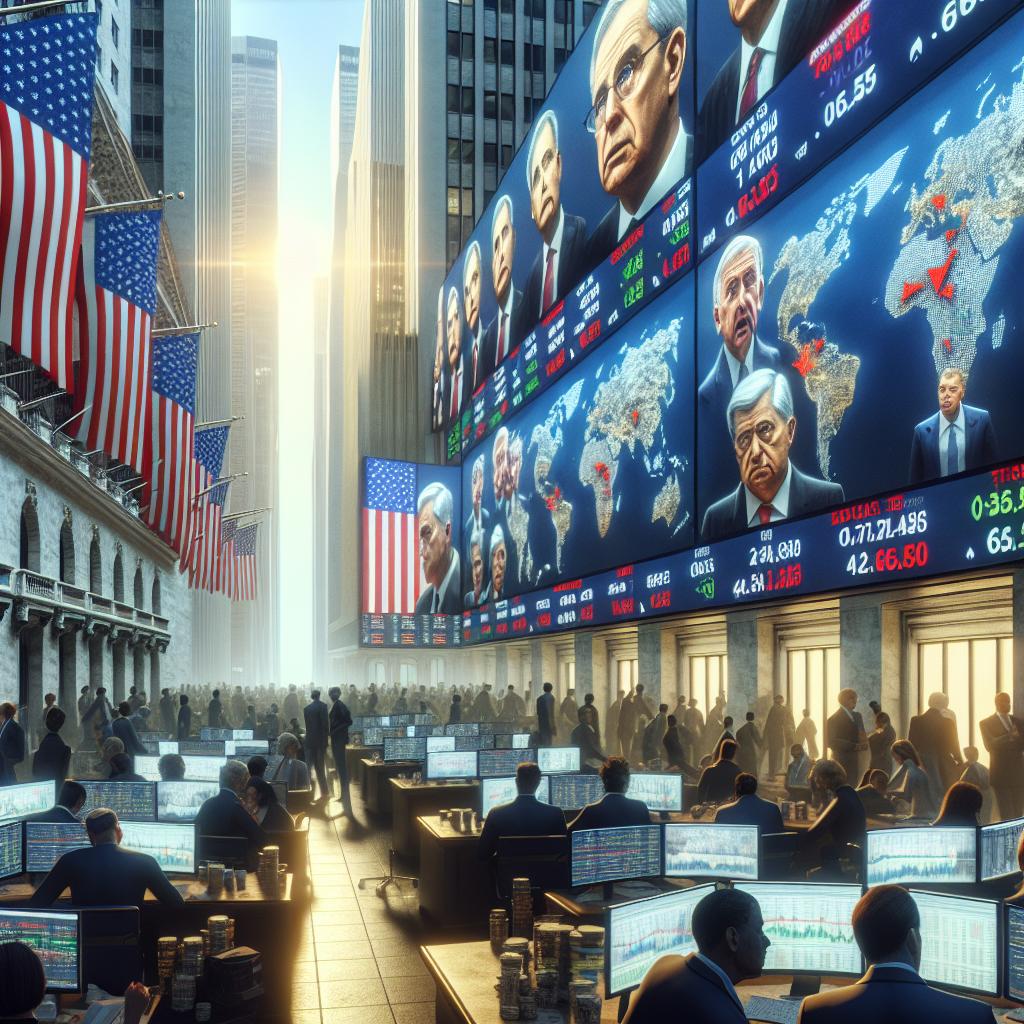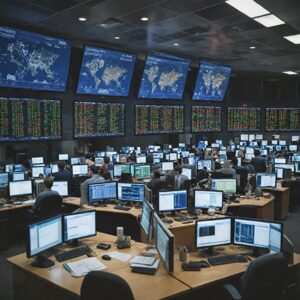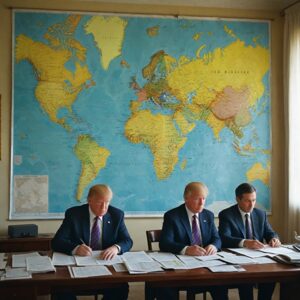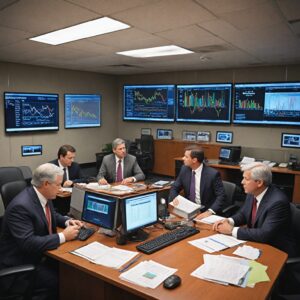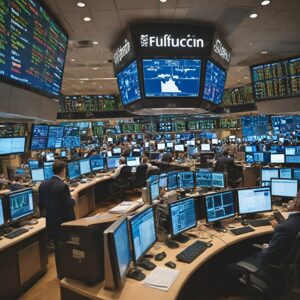Summary
In early 2025, financial markets experienced heightened volatility amid escalating trade tensions between the United States and China, driven largely by President Donald Trump’s imposition of sweeping tariffs on imports. The administration’s trade policies, including plans for tariffs as high as 54% on Chinese goods and additional levies on products from Southeast Asia and the European Union, provoked retaliatory tariffs from China and intensified global economic uncertainty. This tit-for-tat escalation contributed to sharp declines in major U.S. stock indexes, with investors concerned about the impact of protectionist policies on economic growth, inflation, and global supply chains.
Federal Reserve Chair Jerome Powell emerged as a central figure during this period, warning that inflation remained above target and emphasizing the risks trade tensions posed to the U.S. economy. Powell’s hawkish tone on interest rates, coupled with his refusal to offer market-supportive assurances, drew sharp criticism from President Trump, who accused the Federal Reserve of hindering economic expansion. The resulting uncertainty amplified market instability, as investors struggled to interpret the evolving policy landscape amid conflicting signals from the administration and the central bank.
The turning point came when President Trump unexpectedly announced a 90-day pause on tariffs for over 75 countries, excluding China, and adopted a more conciliatory tone toward Powell. This shift sparked a dramatic rebound in U.S. stock markets, with Dow Jones Industrial Average futures soaring more than 700 points and other indexes posting significant gains within minutes. The temporary tariff reprieve offered some relief to investors but did not fully resolve lingering concerns about the sustainability of the trade truce or the broader economic risks posed by ongoing tariff disputes.
Despite the brief market surge, the trade conflict continued to provoke strong reactions domestically and internationally. China escalated diplomatic efforts to counter U.S. tariffs, while economic analysts and business leaders voiced caution about the long-term implications of the tariff strategy. The episode underscored the complex interplay between trade policy, monetary decisions, and market sentiment, highlighting the fragile state of global financial markets amid geopolitical tensions and economic uncertainty.
Background
In early 2025, the global financial markets were significantly impacted by the escalating trade tensions between the United States and its major trading partners, particularly China. President Donald Trump’s administration imposed a series of sweeping tariffs, including plans for levies as high as 54% on Chinese imports and substantial tariffs on products from Southeast Asian nations and the European Union. These tariffs triggered retaliatory measures from China, which announced sweeping 34% tariffs on all U.S. goods starting April 10, further intensifying the ongoing trade war between the world’s two largest economies. This tit-for-tat escalation created substantial economic uncertainty and market volatility, contributing to sharp declines in equities and a downturn in global economic growth prospects.
The uncertainty surrounding tariffs also affected U.S. financial markets, with major indexes such as the S&P 500, Nasdaq, and Dow Jones Industrial Average experiencing sharp losses amid fears over the potential economic impact of protectionist trade policies. Analysts noted that the evolving trade war and the administration’s unpredictable policy decisions made it difficult for businesses and investors to navigate the market environment. The U.S. stock market was on the verge of entering a bear market, weighed down by these concerns and the broader implications for global supply chains and inflation.
Federal Reserve Chairman Jerome H. Powell became a focal point in the financial landscape during this period, as he communicated the central bank’s cautious stance regarding the trade war’s economic impact. Powell warned that inflation, despite some recent easing, remained above target and that achieving the Federal Reserve’s dual mandate of maximum employment and stable prices faced significant risks due to the trade conflict. His indications that interest rates might need to rise further to combat inflation and that the Fed would likely keep rates on hold amid policy uncertainty highlighted the challenges faced by monetary authorities. Powell’s hawkish tone and refusal to promise a so-called “Fed put” to support the stock market drew criticism from President Trump, who accused the Federal Reserve of impeding economic growth through its interest rate policies.
Amid this turbulent backdrop, the markets were sensitive not only to tariff announcements but also to the political and policy rhetoric surrounding them. The market’s reaction to Powell’s testimony and Trump’s public attacks on the Federal Reserve underscored the heightened volatility and uncertainty permeating financial markets during this period. However, a shift in President Trump’s tone, particularly regarding Powell and the approach to China tariffs, triggered a notable surge in market confidence, with futures for the Dow Jones Industrial Average soaring by more than 700 points as investors reacted positively to the prospect of reduced trade tensions and a more stable policy outlook.
Event Description
Following President Donald Trump’s announcement of a 90-day pause on tariffs for more than 75 countries excluding China, U.S. stock markets experienced a sharp rebound. The S&P 500 surged over 7 percent within minutes of the announcement, reversing several days of losses and contributing to one of the most volatile weeks in recent Wall Street history. This tariff reprieve was welcomed by many investors as it temporarily eased the uncertainty surrounding the trade sanctions that had weighed heavily on market sentiment.
However, the volatility persisted due to ongoing concerns about the broader impact of Trump’s trade policies. Federal Reserve Chair Jerome Powell highlighted the uncertainty and potential economic consequences of the tariffs, noting that inflation could rise and economic growth might weaken if reciprocal tariffs were reinstated. Powell emphasized that the Fed would likely maintain current interest rates until more data became available on how these policies would affect the economy.
The market reaction also reflected broader geopolitical tensions, as China responded with diplomatic efforts aimed at encouraging other countries to resist U.S. tariff pressures. Beijing placed its civilian government officials on a heightened alert status and launched a charm offensive to counteract the effects of the U.S. tariffs. Despite criticism from establishment media regarding the disruption to the global trade order, some commentators argued that long-term tariff reductions had not necessarily benefited Western economies, highlighting the complexity of the ongoing trade conflict.
Market Impact
The stock market experienced significant volatility amid President Donald Trump’s trade policies and public pressures on Federal Reserve Chair Jerome Powell. Early in the week, markets reacted negatively due to concerns over the administration’s tariff announcements and the absence of a new trade deal following meetings with Japanese officials. The introduction of reciprocal tariffs by the U.S. and retaliatory measures from trade partners heightened uncertainty about global growth prospects and inflation, causing sharp declines in equities and heightened market instability.
U.S. stock indexes, including futures tied to the S&P 500 and the tech-heavy Nasdaq, rebounded strongly after steep early losses. The Dow Jones Industrial Average futures surged more than 700 points, marking a recovery from earlier turbulence. This bounce followed Tuesday’s dramatic gain where the Dow added over 1,000 points, fueled by optimism stemming from Trump’s softened stance on trade negotiations and a more conciliatory tone toward Fed Chair Powell.
Despite the rebound, the market remained under pressure with the S&P 500 dropping 10.7% in three days following the tariff announcements on April 2. Investors grappled with the unexpected scale of the tariffs, which were broader and more impactful than anticipated, pushing U.S. stocks toward correction territory and near bear market levels. The expanded tariff plans introduced economic uncertainty, intensifying concerns over inflation and future Federal Reserve policy responses.
Surveys indicated a slowdown in business investment and consumer spending, driven by fears of higher prices resulting from tariffs. A Reuters/Ipsos poll found that three-quarters of Americans expected price increases in the near term. While Goldman Sachs lowered its recession probability from 65% to 45%, it forecasted a 15% rise in overall tariff rates, reflecting the persistent economic risks. Treasury officials dismissed market turmoil concerns, emphasizing investments and job creation attributed to the administration’s economic policies.
In response to mounting political and business pressure, Trump announced a temporary pause on certain reciprocal tariffs, an unexpected move that surprised many analysts and investors. This 90-day reprieve provided some relief but did not resolve the underlying uncertainties affecting market sentiment. The continued unpredictability of trade sanctions contributed to ongoing volatility and cautious corporate outlooks.
The uncertainty created by tariff escalations also unsettled major investors. Billionaire investors and Wall Street leaders found themselves sidelined as tariffs persisted, disrupting market confidence and economic forecasts. Despite their influence, appeals to halt the tariff increases were largely ignored, amplifying concerns about the broader economic impact. Nevertheless, some market analysts noted improved risk-reward dynamics following recent pullbacks, highlighting selective stock recoveries amid the fluctuating environment.
Analysis and Reactions
The recent announcements of reciprocal tariffs by the United States, coupled with retaliatory measures from trade partners, have significantly heightened risks to global economic growth and increased uncertainty about the outlook for inflation worldwide. These tariff escalations, driven by President Trump’s protectionist trade agenda, triggered sharp declines in equities and volatility across financial markets. The introduction of new levies not only rattled global markets but also raised concerns about inflationary pressures, with some economists warning that the resulting uncertainty acts as a tax on the economy itself.
White House officials have sought to reframe the narrative amidst the market turmoil by emphasizing the economic benefits of the administration’s policies. A spokesperson highlighted industry leaders’ responses to the “America First” agenda, noting substantial investment commitments expected to create thousands of new jobs despite market volatility. Nonetheless, analysts cautioned that the recent 90-day pause on individualized tariffs, excluding China, offers only temporary relief and does not resolve the fundamental uncertainty plaguing businesses.
Federal Reserve Chair Jerome Powell has been particularly vocal about the economic challenges posed by these developments. Powell warned that inflation remains stubbornly high and that interest rates may need to be increased beyond earlier projections to bring inflation back to the Fed’s 2% target. His hawkish stance surprised some market participants, contributing to additional losses in stocks following his press conference. Moreover, Powell highlighted the dual risks of rising unemployment and persistent inflation, underscoring the difficult policy decisions ahead for the central bank.
The market reaction to Powell’s testimony and Trump’s tariff policies has been swift and multifaceted. Corporate leaders have engaged in extensive efforts to influence the administration’s approach, utilizing phone calls, social media, and shareholder communications to urge reconsideration of tariff measures amid concerns over economic damage. Meanwhile, some members of Congress have voiced apprehension, characterizing the tariffs as risky moves that warrant closer legislative oversight.
Trump’s communication style, characterized by repetition and direct language, has played a strategic role in shaping public perception and rallying support for his policies. However, his unconventional approach has also contributed to market uncertainty, especially when combined with his public comments on Federal Reserve leadership and trade tensions with China. The overall effect has been a complex interplay of policy announcements, market reactions, and economic forecasts, creating a volatile environment for investors and policymakers alike.
Aftermath
Following President Trump’s announcement of a 90-day pause on certain tariffs and a more conciliatory tone toward Federal Reserve Chair Jerome Powell, U.S. stock markets experienced a significant rebound. Futures tied to the S&P 500 and the tech-heavy Nasdaq rose by 2.5% and 3%, respectively, while those linked to the Dow Jones Industrial Average surged more than 700 points, or 1.8%. This marked a strong recovery from the steep declines experienced earlier in the week amid growing concerns over the impact of Trump’s tariff policies and repeated criticisms of Powell.
Despite the rally, analysts cautioned that the tariff reprieve did not eliminate the substantial uncertainty still clouding the market. The ongoing unpredictability surrounding the administration’s trade sanctions meant companies remained uncertain about how future policy shifts might affect their operations. Moreover, the broader economic outlook remained fragile due to the extensive tariff measures introduced earlier in the year, which had already placed U.S. stocks in correction territory and raised fears of a potential bear market.
The Federal Reserve, led by Chair Powell, had been increasingly vocal about the economic risks posed by the sweeping tariffs. Powell warned that such levies would likely stoke inflation, reduce economic growth, and increase unemployment, contradicting the President’s optimistic assertions regarding the impact of tariffs on prices. The Fed’s stance contributed to market volatility, especially as investors grappled with uncertainty about the central bank’s future monetary policy moves and Powell’s perceived hawkish tone at recent press conferences.
Trump’s tariff strategy, including the implementation of reciprocal tariffs and threats to expand duties under Executive Orders, continued to provoke strong reactions domestically and internationally. The escalation triggered retaliatory measures from trade partners, further heightening risks to global growth and inflation expectations. Additionally, China responded by sending formal communications to other governments, emphasizing the need for multipolarity and solidarity against U.S. policies perceived as protectionist.
The market’s rebound following the tariff pause reflected relief among investors but was tempered by lingering concerns over the trajectory of U.S. trade policy and its broader economic consequences. Hedge fund managers and financial experts voiced calls for a reassessment of the administration’s approach, warning that missteps could have severe repercussions for the global economy if corrective measures were not taken promptly. Meanwhile, companies affected by the tariffs remained cautious, with some even doubling down on their investments in China despite the trade tensions.

